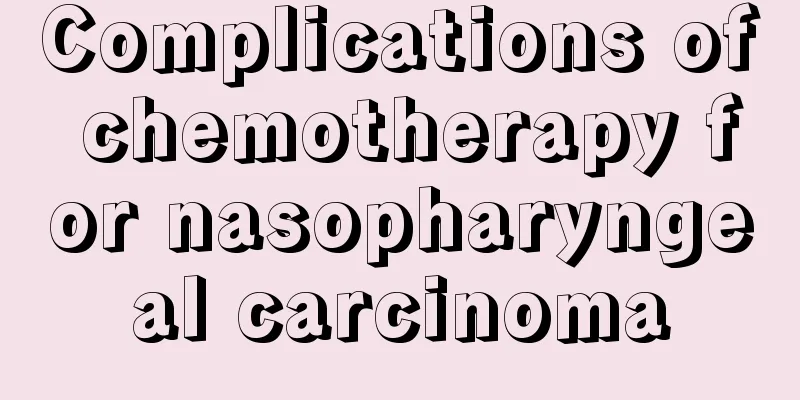Complications of chemotherapy for nasopharyngeal carcinoma

|
Complications of chemotherapy for nasopharyngeal carcinoma? Most nasopharyngeal carcinomas are poorly differentiated adenocarcinomas, which are sensitive to radiation. Therefore, the current treatment of nasopharyngeal carcinoma is mainly radiotherapy. However, the complications after radiotherapy for nasopharyngeal carcinoma cannot be ignored by patients and their families. If the complications after radiotherapy for nasopharyngeal carcinoma are not handled and resolved in a timely manner, it will definitely affect the patient's treatment effect, and in severe cases it will cause other complications that endanger the patient's life. Common complications after radiotherapy for nasopharyngeal carcinoma 1. Systemic adverse reactions: Due to the intake of radiation, the human body will have systemic abnormal reactions, such as fatigue, dizziness, poor appetite, nausea, vomiting, insomnia or drowsiness. For most patients, the blood picture or liver and kidney function will not be significantly affected. For some sensitive people, it will also cause a decrease in white blood cells and platelets. For patients with poor liver function or positive hepatitis A antigen (HAA) or cirrhosis, it will cause liver damage and special attention should be paid. 2. Acute radiation reaction of parotid gland: Within the first 1-2 days after the start of radiation, the patient will complain of swelling and pain in the parotid area on the irradiated side. This is due to acute congestion of the parotid tissue caused by radiation. The swelling generally does not require treatment and will subside on its own after 3-4 irradiations. 3. Skin radiation reaction: The skin in the irradiation field of nasopharyngeal carcinoma will cause a series of skin reactions after being exposed to radiation. The initial symptoms are skin erythema and pigmentation, followed by hair loss, dry peeling, and in a few patients, blisters will form, which will fuse into large areas of moist dermatitis and superficial ulcers. The severity of the skin reaction is related to the quality and dose of the radiation. High-energy radiation can relatively reduce skin reactions, but individual differences are also very important factors. Different patients may have completely different skin reactions under the same conditions and the same dose. 4. Mucosal reaction: Mucosal reaction refers to the increased congestion, edema, and exudation of the oral, oropharyngeal, nasopharyngeal, nasal, and paranasal sinus mucosa after a certain period of irradiation. In severe cases, punctate or flaky white film may appear, with symptoms such as pain, difficulty eating, nasal congestion, and increased viscous secretions. Almost every patient has these mucosal reactions, but the severity varies. 5. Wet reaction in the external auditory canal or otitis media: When the external auditory canal is exposed to radiation doses of about 50 GY, the ear canal mucosa may react wetly or the middle ear may accumulate fluid or the ear canal membrane may be pierced to form pus. Early prevention should be adopted, such as the use of antibacterial ear drops, and early administration of needle drops when there is fluid accumulation in the ear canal to prevent excessive accumulation of fluid from causing tympanic membrane rupture. When there is repeated middle ear effusion, a plastic tube can be placed for drainage. 6. Radioactive facial and neck edema: This is due to poor lymphatic drainage of the face and neck tissues after irradiation, edema and occlusion of deep capillaries, and obstruction of microcirculation, which causes facial and submandibular edema. Generally, no special treatment is required for edema of the neck, which can disappear on its own 4-6 months after radiation. If the edema is severe and induces infection, and causes acute cellulitis, it should be actively treated, preferably with high-dose intravenous antibiotics. In severe cases, anti-edema drugs, hormone mouth and leg cleansers, and symptomatic treatment should be given at the same time. |
<<: Diagnosis and treatment of nasopharyngeal carcinoma
>>: Standard nursing plan for nasopharyngeal carcinoma
Recommend
Does Ehime orange make you get angry?
Fruit is an indispensable food in people’s daily ...
Can mild gastric bleeding heal itself?
Our stomach and intestines are responsible for di...
What kind of care is provided before rectal cancer surgery?
Rectal cancer is a common malignant tumor in the ...
What symptoms may lung cancer patients experience
Lung cancer often does not show clinical symptoms...
Cases of pancreatic cancer cure
Can pancreatic cancer be completely cured? In rec...
Diet during chemotherapy for endometrial cancer
We all know that diet is the most important part ...
What is the main factor that causes colorectal cancer
Colorectal cancer is more common in life. It is a...
How can fibroids be cured?
Many patients with fibroids are very worried abou...
Causes of high urine sugar
All food and nutrients that the human body ingest...
Detoxification phenomenon after meridian dredging
Meridian detoxification is a method often used by...
How to cure laryngeal cancer?
The throat is one of the most important organs of...
What is the reaction after taking a bath?
Generally speaking, in winter, many people will e...
What should be checked 42 days after delivery?
Everyone knows that during pregnancy, you should ...
What to do if you eat foot odor salt
Salt plays an indispensable role when cooking, so...
Chinese medicine treatment of pancreatic cancer patients should pay attention to the following points
Traditional Chinese medicine is one of the treatm...









